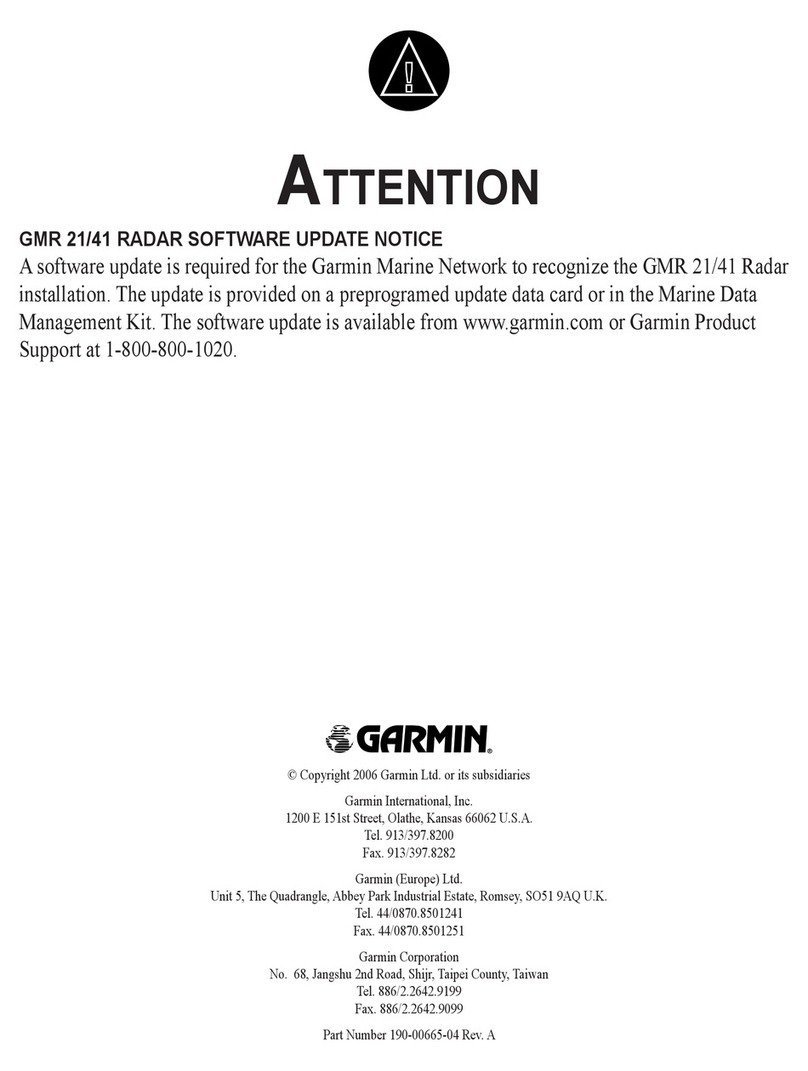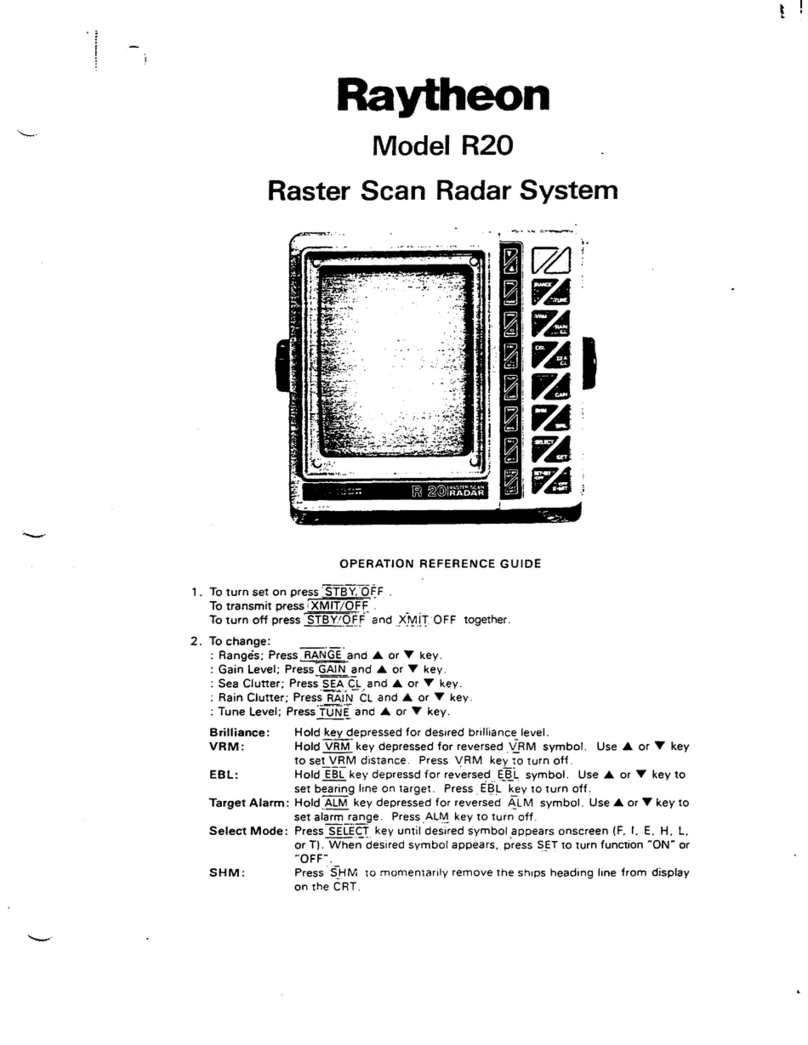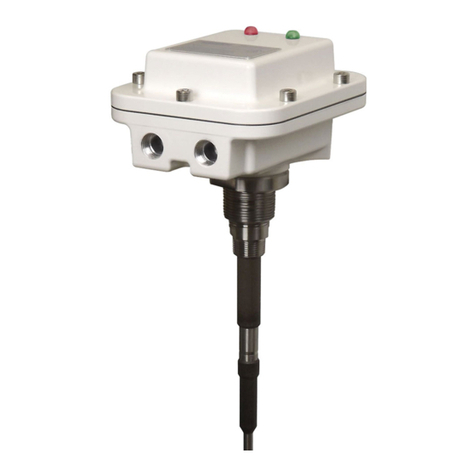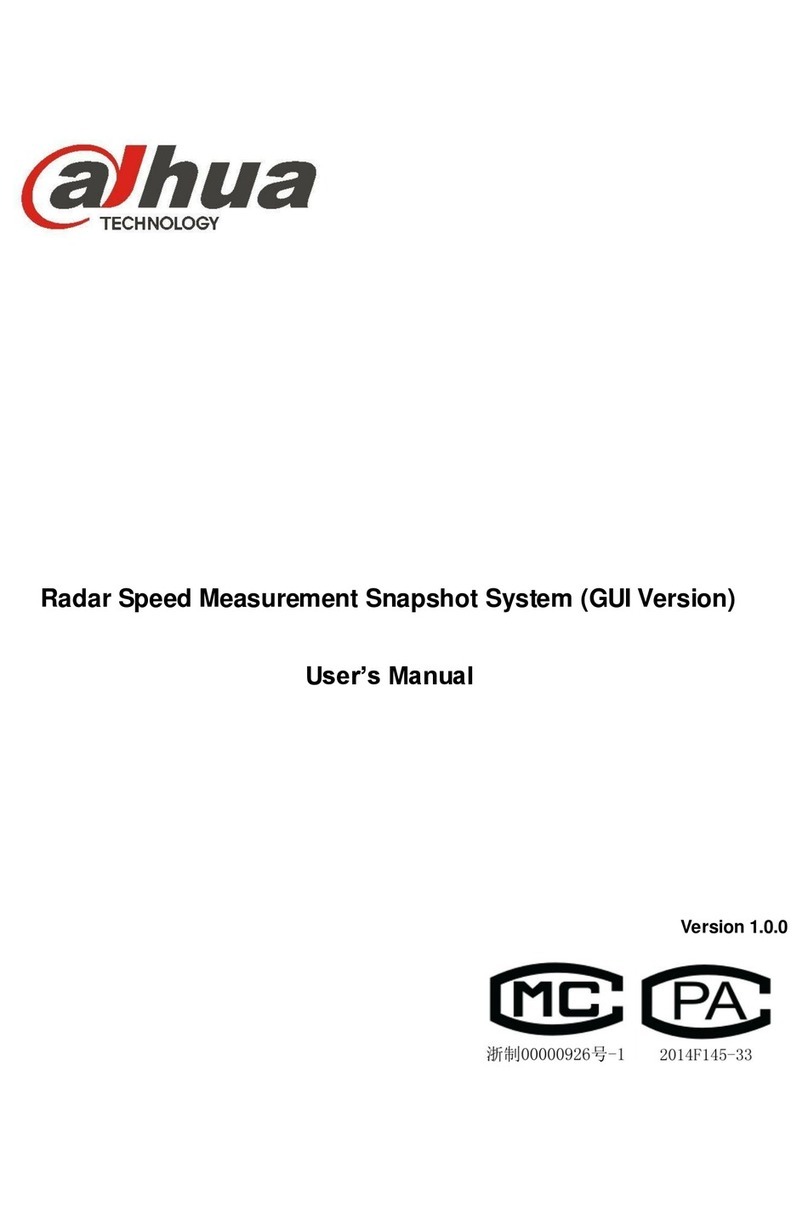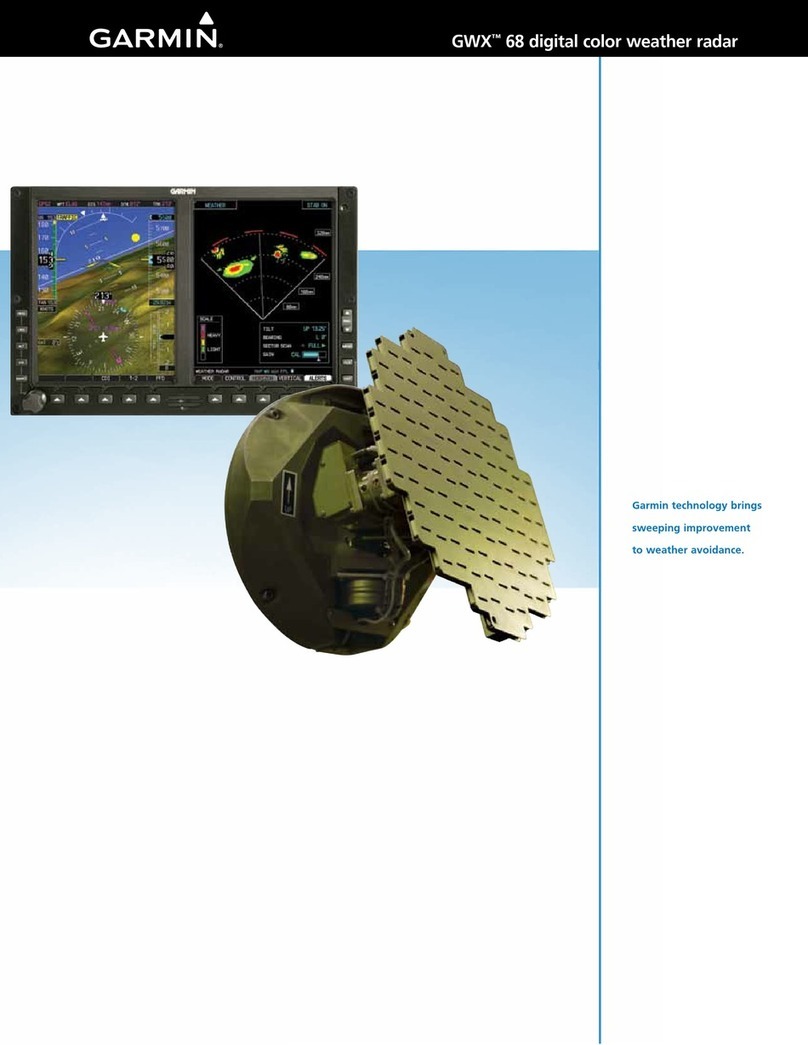Infinition Labradar User manual

LabRadar
User Manual
Certification : Under approval
For Technical assitance, please contact :
Canadian customers should return to:
Infinition Inc.
2455 de l’Industrie
Trois-Rivieres (QC) Canada
G8Z 4T1
316-866-2525
All others should return to:
TCK, LLC
8221 W. Meadow Pass Ct
Wichita, KS 67205
U.S.A.
316-866-2525

Infinition Inc. Rev. 02
2
Important Safety Instructions
1. Carefully read all of the instructions provided and save them for later use. Read all warnings and
instructions marked on the LabRadar.
2. Do not place the LabRadar on an unstable stand or surface as it may fall resulting in serious
damage.
3. The LabRadar must be operated either by 6 AA batteries or by plugging the USB cord to a
computer’s USB port.
4. Do not allow any objects to rest on the USB cord or place the LabRadar where the USB cord will be
trampled on.
5. Do NOT plug in, turn on or attempt to operate an obviously damaged unit.
6. No operator serviceable parts inside the LabRadar radar unit. Please refer servicing to service
qualified personnel.
Notes:
This equipment has been tested and found to comply with the limits for a Class B digital device, pursuant to
part 15 of the FCC Rules. These limits are designed to provide reasonable protection against harmful
interference in a residential installation. This equipment generates, uses and can radiate radio frequency
energy and, if not installed and used in accordance with the instructions, may cause harmful interference to
radio communications. However, there is no guarantee that interference will not occur in a particular
installation. If this equipment does cause harmful interference to radio or television reception, which can be
determined by turning the equipment off and on, the user is encouraged to try to correct the interference by
one or more of the following measures:
Reorient or relocate the receiving antenna.
Increase the separation between the equipment and receiver.
Connect the equipment into an outlet on a circuit different from that to which the receiver is
connected.
Consult the dealer or an experienced radio/TV technician for help.
This devices complies with Industry Canada license-exempt RSS standard(s). Operation is subject to the
following two conditions:
1. This device may not cause harmful interference;
2. This device must accept any interference received, including interference that may cause undesired
operation of the device.
Cet appareil est conforme à Industrie Canada une licence standard RSS exonérés (s). Son fonctionnement est
soumis aux deux conditions suivantes:
1. Cet appareil ne doit pas provoquer d'interférences
2. Cet appareil doit accepter toute interférence reçue, y compris les interférences pouvant provoquer un
fonctionnement indésirable de l'appareil.
!

Infinition Inc. Rev. 02
3
1. General
LabRadar utilizes the latest technological advances in Doppler Radar to obtain the velocity of your
projectile. Your unit contains a transmitter and a receiver with sophisticated software that processes the
Doppler signal to immediately provide you with the velocity of your projectile. LabRadar captures the event
after the sound impulse from the firearm being used. The system also contains an alternate mode (Doppler)
that allows it to capture velocities of projectiles fired from other systems with a less audible response. Since
radar signals travel at the speed of light LabRadar is able to accurately detect velocities at sub-sonic, trans-
sonic and supersonic speeds. Unlike traditional chronographs that are highly susceptible to variances in
lighting conditions, bullet glint, sub-sonic bow waves LabRadar is accurate in virtually any condition.
LabRadar is positioned besides the shooter, not downrange. The shooter aligns the radar using a built-in
sighting notch with the target he intends to shoot. Ideally, LabRadar should be positioned to the side of the
shooter’s muzzle. You should position your firearm no greater than 18” from the side of the radar. If you are
shooting a firearms that may discharge debris that could strike the radar it may be best to move the firearm
slightly forward so the muzzle, cylinder gap, ejecting cases or other discharge will not damage your
LabRadar. Upon firing the shot, the radar unit will begin transmitting and will continually track the bullet,
reporting numerous velocities along its path. Based upon the large amount of data gathered from the tracked
projectile the muzzle velocity can also be determined.
2. Microwave Safety Warning
3. Specifications
Description Specification
Power Requirement 6 AA Batteries or USB powered, 800mA
Frequency range of operation 24.080 to 24.168 GHz 8MHz channel steps
Nominal Transmitting Power 4.84 dBm
Antenna Gain 22 dBi
Transmitter Stability ±2 ppm
Beamwidth 7.6° x 18.5° (Transmit)
Dimension 29cm x 26cm x 6cm (2.1 lbs)
Mounting Hole Thread: 1/4x20
Velocity Range: 100-4,000 feet per second
Memory Type/Capacity: SD Card 32Gb max.
Minimum Time Between Shots: [TBD]
Accuracy: +/-0.1% (+/-1 m/s @ 1,000 m/s)
Operating Temperature -10degC to 40degC
Environmental conditions Outdoor
Assembled in Canada
Made in [TBD]
Based on limits specified by the Federal Communication Commission (FCC) on Radio
Frequency (RF) emissions in a general population environment, continued exposure to
radiation should be avoided within 0.2 meter in front of the radar. Radiation levels outside this
region fall within regulations of 1 mW/cm2and are not considered safety hazards. When setting
up the antenna, special care should be taken to avoid situations where the antenna radiates
towards individuals. The antenna should be positioned such that bystanders are located behind
the antenna. Always turn the antenna transmitter off during periods of inactivity. Direct visual
contact with the front of the Labradar when transmitting should be avoided at all times.
!

Infinition Inc. Rev. 02
4
4. Operation
A USB cord is provided for connection to a computer. The USB cord is used to power the radar and access
data on the SD card.
The SD card is used to both store data from series and for firmware updates.
A LED is used to indicate the status of the radar:
LED status Description
Off Unit is Off
Blue Unit is powered On, not transmitting.
Red Unit is powered On, transmitting (Armed)
Flashing Red Unit is powered On, transmitting, system will stop transmitting shortly (within
10 seconds) if no trigger is detected.
4.1 Buttons definition
The LabRadar is equipped with an array of buttons each used for a different function:
1. Display / Parameters
2. Series
3. Delete
4. Up
5. Enter
6. Down
7. Power
8. Arm
9. SD Card
10. USB Connector /
External Trigger connector
11. Battery Compartment
12. Sighting Notch
13. LED Indicator
14. Internal acoustic trigger
sensors (2x)
14 14
1
2
3
4
5
6
7
8
9 10
11
12
13

Infinition Inc. Rev. 02
5
4.2 Configuration Menu definitions
When the Display/Parameters button is pressed, a menu appears. The following options are available:
Menu selection Description
Velocity Units Change the units used when displaying velocity measurements, the user can
choose from the following units:
Feet per second (fps);
Yards per second (yps);
Miles per hour (mph);
Meters per second (m/s);
Kilometers per hour (Km/h).
Distances units. Change the units used when displaying distance measurements, the user can
choose from the following units:
feet (ft);
yards (yd);
meters (m).
Weight units Change the units used to enter the weight of the projectile, the user can
choose from the following units:
gram (g);
grain (gr).
Select vel. range Select the velocity range for measurements by the LabRadar. Each velocity
range is specified to weapons type as a reference:
Rifle (300m/s to 1050m/s);
Handgun (75m/s to 525m/s);
Archery (20m/s to 225m/s).
Set proj. offset Input the distance between the gun’s muzzle and the side of the radar to
optimize the precision of the measurements.
Set distances Specify the distances at which the velocity measurements are made. Dx1 to
Dx5.
Proj. Weight Set the projectile’s weight of the next shot. This value is used in some
calculations (Power Factor, Kinetic Energy) and written on the file on the SD
Card for future reference.
Arm time Change the amount of time the radar stays in transmission before it stops
transmitting automatically. This count will be reset each time a trigger is
received.
Screensaver:Select the idle time before the screen is turned OFF, this is an energy saving
feature. The device will continue to operate while the screen is turned off,
pressing a button or triggering the unit will wake up the screen.

Infinition Inc. Rev. 02
6
Trigger Source Select the source of the event triggering the measurement. The user can
select from the following:
Trigger : Use the internal microphones built in the
product’s enclosure or an external Trigger device.
Doppler : Use the Signal returned from the projectile to
Trigger the unit: (Use of this mode should be considered with
large projectiles travelling at really slow speed only). Do not
use this mode for Firearms, it will affect the precision of the
measurements.
Trigger Level Select the sensitivity of the system to detect the trigger event. The user can
select level 1 (more sensitive) through 5 (Less sensitive). This setting
affects:
The Internal acoustic trigger level;
The External trigger level;
The Doppler trigger level;
TX Channel Select the frequency of transmission of the Radar. In order to use multiple
radars close to each other, use a different frequency for each radar. Failure
to do so may result in bad operation of the radar. For contiguous Labradar,
try to use at least a 2 channels separation.
TX Power (US, Canada, Australia models only)
Select the LabRadar transmitting power. (High or Low). While High power
offers a longer range measurement range, the low power mode can be useful
and perform better on shorter shooting ranges and on ranges where object
create signal reflexions.
System Date Set the system Date.
System Time Set the system time.
Format SD Card Format the memory card (SD card) inserted in the unit.
WARNING: Performing this action will delete the data on this card and it
will be lost forever. This action can take a few minutes to complete, do not
remove the SD card or turn off the LabRadar while operation is in progress.
Format Int. Mem. Erase the results from the internal memory of the device.
About View the radar’s information (Serial Number, Firmware version, etc.)

Infinition Inc. Rev. 02
7
4.3 Using the LabRadar
Turn on LabRadar by pressing the Power Button. You will see a blue light to indicate the unit is on.
4.3.1 ALIGNING THE RADAR
Locate a suitable position for your LabRadar and position it within 18 inches to either side of the muzzle of
your firearm. The unit contains a ¼ inch x 20 threaded plate on the base of the unit for mounting on a
standard tripod. To properly align the radar look through the sighting notch located in the top center of the
unit and aim the radar at the target that you will be shooting at. Make sure it is in a stable position to insure
that there is no movement after you align it with your target.
Place the LabRadar in a position where it will not be impacted by ejecting cartridge cases, muzzle
debris/blast or other items.
The LabRadar SHOULD NOT be in front of your muzzle. It is acceptable to place your muzzle in front of
the LabRadar. Ideally it should be in a position where you can see the display screen from your position to
prevent unnecessary movement.

Infinition Inc. Rev. 02
8
4.3.2 Armed Mode (Red indicator)
With the radar turned ON, press the ARM button until the radar indicator turns Red. The unit is now in
armed mode.
The radar is now transmitting and waiting for an appropriate Trigger to be received. The unit will remain in
Armed mode until either:
The unit is manually disarmed by pressing the arm button or;
The unit is disarmed automatically as it has not received a Trigger for a while. This time
corresponds to the Arm Time in the Configuration Menu (See Section 4.2)
* Once the light begins to flash, you will have 10 seconds to fire the shot before the Arm Time has expired.
After a successful shot, the Shot number will be increased by 1 and the resulting measurements will be
displayed on-screen.
4.3.3 Last shot review mode (Blue indicator)
If the system is armed and is then disarmed (either manually or automatically), the indicator turns blue and
the Last shot is displayed on screen as show here:

Infinition Inc. Rev. 02
9
4.3.4 Armed View mode (Red indicator)
When the system is armed, the indicator turns Red. The last shot of the current series is displayed and if a
Trigger is received, the system will display the new shot on screen. The screen displayed is identical to the
Last shot review.
4.3.5 Review Mode (Blue indicator)
The review mode allows the user to navigate through all the results available in the LabRadar. When it it
turned ON, the LabRadar starts in Review mode. To access the Review mode from the Last shot review or
the Armed view, the user should hold the arm button for 2 seconds. The Review mode display should
look like that:

Infinition Inc. Rev. 02
10
4.3.5.1 Managing results in Review mode
First, make sure you are in the Review Mode as show above, then:
To navigate through the results, use the UP and DOWN arrows.
To make a new Series press the Series button and confirm your choice by using the up/down
arrows and pressing Enter.
To delete a series press the Delete button and confirm your choice by using the up/down arrows
and pressing Enter. WARNING: this action is irreversible.
To access individual shots, first select your series with the arrows, then press Enter
To delete a Shot press the Delete button and confirm your choice by using the up/down arrows
and pressing Enter. WARNING: this action is irreversible.
4.3.6 Screensaver
If the display screen turns off, press any key, except power, to turn the display on.
4.3.7 Battery Installation
Install six (6) AA alkaline battery in the battery compartment. When not in use remove the batteries. To
conserve your batteries you should keep the Armed time setting at a minimum and the Screensaver time at a
minimum. It is advisable to have a spare set of batteries available.
* The unit can also be powered by a USB power supply through the USB port. 5V @ 1A is required.
4.3.8 Memory
The use of SDHC cards of known brandings is recommended. Regular SD card, SDXC and others may fail
to work in the device.
With the unit turned off insert a SD Card with sufficient memory to record the shots you anticipate taking.
Should you need to remove the SD Card always turn the power off prior to removing the SD Card. Make
sure the SD Card is clean and free of debris before inserting. Keep the SD slot cover in place to protect it
from dust, moisture, etc.
If no SD Card is inserted, the system will record the shots in its internal memory. As this memory space is
limited, you can only get advanced reports published on an SD card.
4.3.9 USB Port
Make sure the USB port is clean and free of debris. Keep the USB cover in place to protect it from dust,
moisture, etc.
4.3.10 Downloading Data
* You need an SD card in your device before you can download any data.
You can access the data by connecting a USB cable on the LabRadar and to a computer. The computer
should recognize the LabRadar as a Mass Storage Device and display the files available on the SD Card.
Alternatively, the user can turn OFF the LabRadar and remove the SD card to read it in a memory card
reader (Fastest).
The data needs to be recorded while the SD card was in the device to be accessible later by USB.

Infinition Inc. Rev. 02
11
The data recorded in the internal memory only (while there was no SD card inserted) cannot be accessed by
USB.
4.3.11 Recording Projectile Velocities
Each shot is recorded in the sequence that it was fired in. The Series and Shots can be reviewed on LabRadar
or on a PC at a later time. LabRadar provides the ability to record up to 1,000 shots in 1,000 different series.
The only other limitation is the space available on the SD card.
4.3.12 Series and Shot Navigation
When the LabRadar detects a projectile the velocity is recorded in the currently selected Series. This causes
the number of shot velocities in the Series to increase by 1. This will continue until the user selects another
series number. The first shot of that series will be shot 1 and will continue counting up until another Series in
selected.
If the system is turned off, it will continue to record shots in the last series used when power is restored.
Should you choose to fire additional shots in a previous series toggle back to that Series and continue firing.
The additional shots will be recorded in the selected Series.
4.4 Display details
Battery Indicator
There is an icon on the display of the LabRadar that indicates the battery condition. If the battery voltage
becomes insufficient to operate, the system will shut down.
Bluetooth Indicator
There is an icon on the display of the LabRadar that indicates when a Bluetooth connection is active. When
there is no Bluetooth connection, the icon is not shown on screen.
Radar Signal Strength Indicator
The signal strength indicator is located on the side of the measurements results of the last shot, either in the
Armed View or the Last shot review mode. It gives an indication on the quality of the signal that is analyzed
by the device. 5 bars = Best, 1 bar = Bad signal.
Instructions
Error Message
If the LabRadar is receives a trigger event but does not detect valid projectile signal, the following message
will be displayed on-screen: “Acquisition error: could not track the projectile”. The system will not record
that shot, neither will it make any measurements.
Before trying again, check the following:
The alignment of the radar unit.
Confirm that a projectile went through the Labradar beam area
Check your weapon to insure it operated properly and is safe to fire again
In the event the unit is powered off or the battery is depleted, the shot data is stored on
the SD card and no data will be lost.
8/14structions
Extreme Spread (ES)
The Extreme Spread, is the lowest velocity subtracted from the highest velocity of the current series.

Infinition Inc. Rev. 02
12
Standard deviation- A number used to tell how measurements for a group are spread out from the average,
or expected value. A low standard deviation means that most of the numbers are very close to the average. A
high standard deviation means that the numbers are spread out.
Lowest: The lowest Velocity of the current Series.
Highest: The highest Velocity of the current Series.
Average: The average Velocity of all shots in the current Series.
5. Maintenance
The LabRadar radar does not require much maintenance. Attention should however be paid to a few
points:
-Keep the connectors clean from dirt and moisture to avoid corrosion and bad connections.
-Now and then wipe the radar enclosure with a soft and wet cloth.
-The circuits are protected by a plastic enclosure. Special attention should be paid when handling the
radar to avoid damaging the plastic enclosure as it could result in performance degradation.
6. USB Connector Specification
Connector type: USB micro Type A female on unit
7. SD Card Connector
Connector type: SD Card Socket (Standard)
8. Trigger Input Connector
Connector type: Stereo 1/8” stereo audio jack with specific pinout (Do not connect headphones)
Safety Information:
1. Always keep the weapon pointed in a safe direction, and keep your finger off the
trigger, until you are ready to shoot.
2. Firearms should be unloaded and securely stored when not in use.
3. Be sure of your target and backstop before you shoot.
4. Wear shooting glasses and ear protection when you shoot.
5. Don’t shoot at a hard surface or at water.
6. Avoid alcoholic beverages or drugs when shooting or handling a weapon.
7. The launching of any projectile involves risk of injury/death to persons and damage to
property. You are responsible for any such actions and their consequences.
8. Always place LabRadar in a safe position to avoid damage to the unit.
All these important safety rules must be followed at all times by persons handling any
weapon.
Warning: No operator serviceable parts inside the radar unit. Please refer
servicing to service qualified personnel
!

Infinition Inc. Rev. 02
13
9. Range
The LabRadar is a consumer level device that was designed for amateur use only. The performance of
the units has been optimized to offer the most accurate results, but it is possible that some reading are
not accurate, hence it is the responsibility of the user to determine whether or not the readings are good
or not to its satisfaction. Infinition and its subsidiaries will not be responsible for inaccurate readings.
In order to achieve the best accuracy possible, the user must use the product correctly and take care of
some details:
Make sure that the Labradar is aligned correctly with the target.
Make sure that the position of the gun relative to the LabRadar is correct.
Use a firing range that has no obstacles or obtrusions close to or in the line of fire. (Clear line
of sight)
Make sure that the parameters entered in the LabRadar configuration match you installation.
Due to microwaves signals nature, range performance of the LabRadar can differ depending on the
environmental conditions:
Temperature;
Humidity;
Particles in the air;
Signal reflection on the ground, trees, wall and any other surface in the line of fire.
Frequency channel used for transmission;
Etc.
In addition, the projectile’s characteristics will also affect the range performance of the LabRadar, such
as:
Projectile’s diameter;
Projectile’s tail design;
Projectile’s shape;
Projectile’s position while travelling in the air;
Subparticles;
Etc.
Thus, it is a known fact that range performance can vary, even for the same bullet calibers depending
on the manufacturer of the bullet, the model of the bullet, the firearm used to fire the bullet, the tail
shape of the bullet, etc. Infinition and its subsidiaries cannot explicitly guarantee a range performance
and thus will not be responsible for range performance difference between shots.
Estimated maximum range
Projectile diameter Maximum range
(m/s

Infinition Inc. Rev. 02
14
10. Firmware upgrade
The LabRadar’s firmware can be upgraded to the latest version at any time. Please check our website
to check availability.
In order to upgrade your firmware:
1. Download the latest version on our website;
2. Copy the file on the LabRadar’s SD Card root (1 or 2 files);
3. With the LabRadar turned OFF, insert the SD card in the LabRadar;
4. Turn the unit ON;
5. The Blue LED will blink and the LabRadar will restart;
6. The firmware version will be displayed on the radar;
7. The Firmware update file will be deleted from the SD card.
Warranty
INFINITION, INC., warrants that LabRadar is manufactured to be free from defects in material and
workmanship for a period of one (1) year from date of purchase by the original purchaser for non-
commercial use. Any other use of this product voids the warranty. INFINITION, INC. at its option,
will repair or replace without charge, or refund the purchase price of any product which fails during the
warranty period by reason of defect in material or workmanship found upon examination by
INFINITION, INC. This warranty does not cover any failures caused by abuse, mishandling, failure to
the follow the operating instructions, alteration(s) or accident. Damaged caused by bullet impacts,
gunfire debris or ejecting materials are not covered by warranty. To make a claim under this warranty,
the original purchaser must return the product to the address shown below. The unit should be properly
packaged with the shipping charges prepaid. All claims must be made within thirty (30) days after the
product failure. All claims must be accompanied by proof of date of purchase or confirmed by the
products online registration.
Prior to returning any item call or email for a Return Authorization Number. Items returned
without the authorization number will be rejected and returned to sender. Infinition will not be
responsible for any lost shipments or other liabilities. The RMA can be requested by contacting
the following:
Canadian customers should return to:
Infinition Inc.
2455 de l’Industrie
Trois-Rivieres (QC) Canada
G8Z 4T1
techsupport@mylabradar.com
316-866-2525
All others should return to:
TCK, LLC
8221 W. Meadow Pass Ct
Wichita, KS 67205
U.S.A.
techsupport@mylabradar.com
316-866-2525

Infinition Inc. Rev. 02
15
CONSULT WITH PROPER GOVERNMENT AUTHORITIES BEFORE EXPORTING or
IMPORTING THIS ITEM.

Infinition Inc. Rev. 02
16
Troubleshooting
My shot did not record:
Make sure the power is on and the display is visible
Make sure the indicator light is Red while the shot is fired
Realign the radar
Place your firearm closer to the side of the unit.
The display goes black while shooting
Adjust the Screensaver time in the preferences menu to a longer time
Touch any button, except Power or Arm, to disengage the Screensaver.
The Labradar will turn OFF and back ON when armed : Check the batteries level.
The Labradar will not power ON: Check the batteries, replace if needed. / Check the USB
connection, if power supply is powered on. Press the Power Button.
Popular Radar manuals by other brands

Furuno
Furuno FAR-3210 installation manual
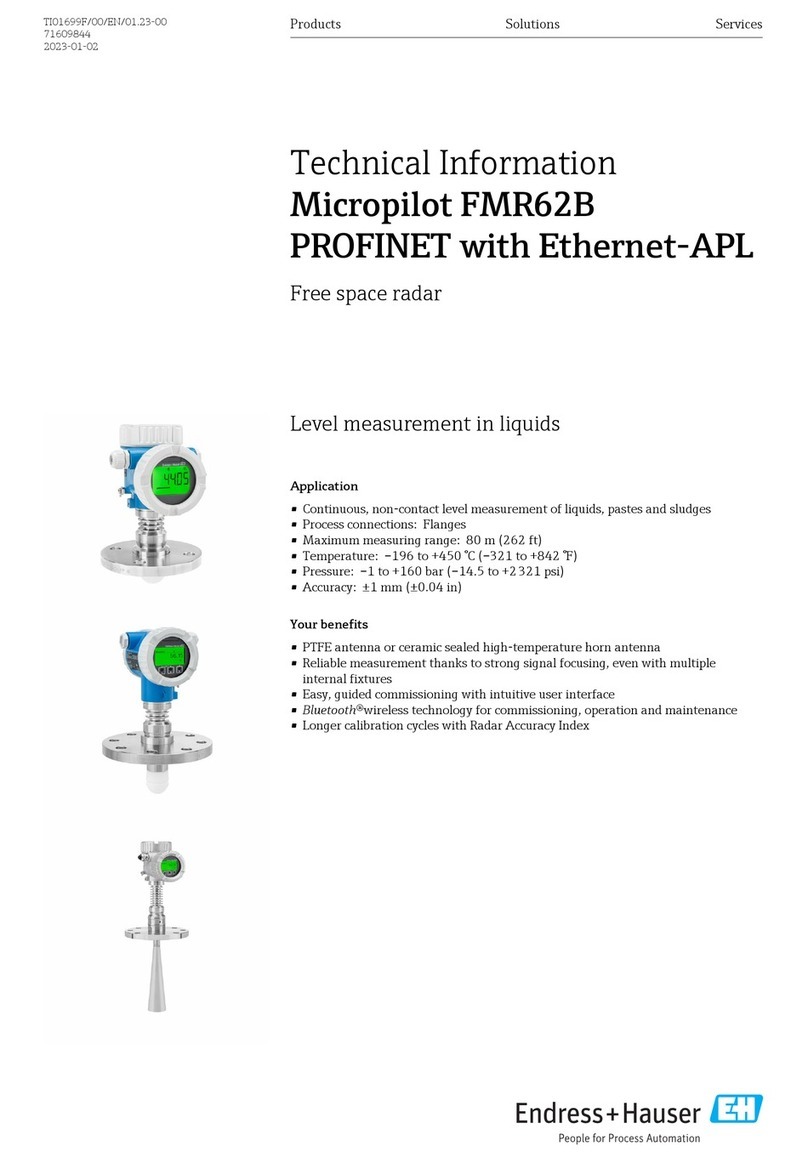
Endress+Hauser
Endress+Hauser Micropilot FMR62B PROFINET with Ethernet-APL technical information
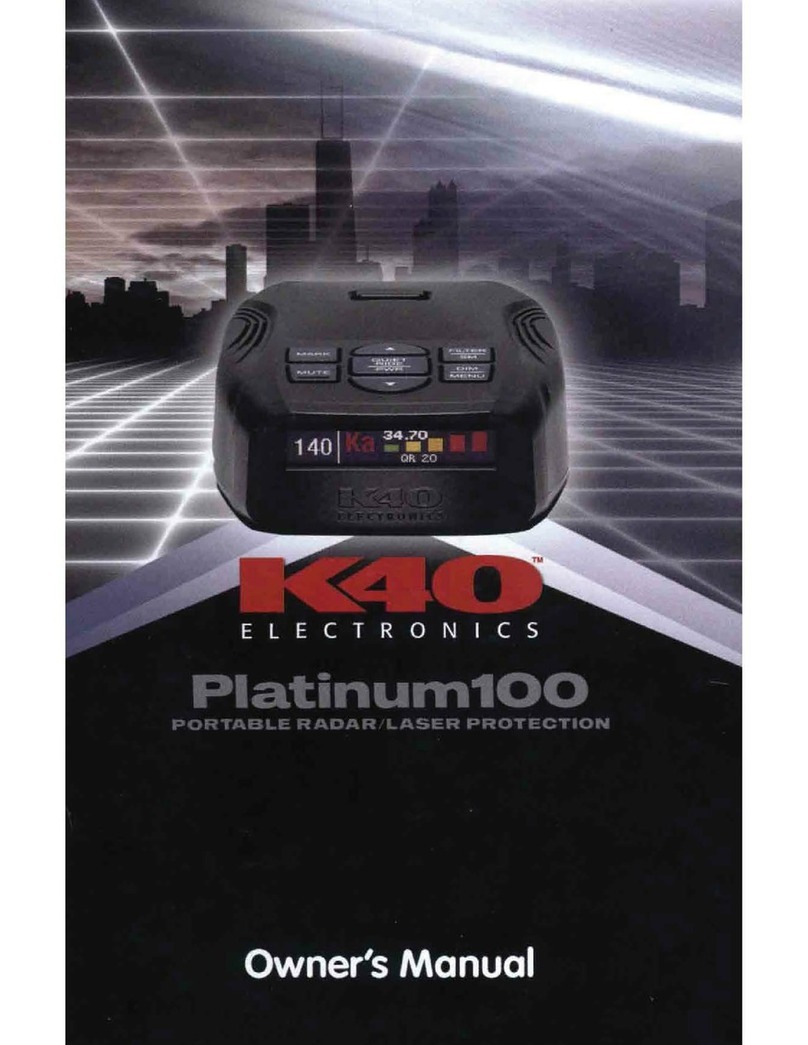
K40 ELECTRONICS
K40 ELECTRONICS Platinum 100 owner's manual
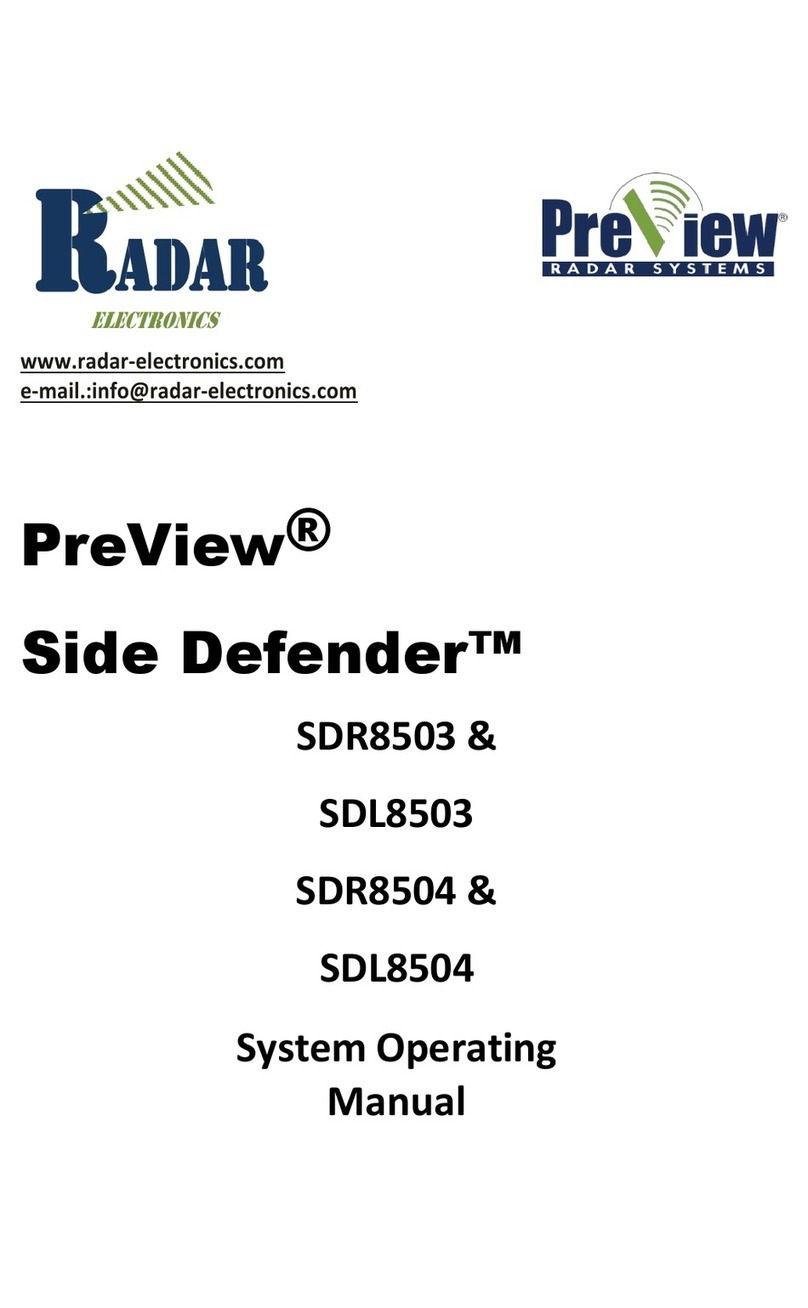
Radar Electronics
Radar Electronics PreView Side Defender SDR8503 operating manual
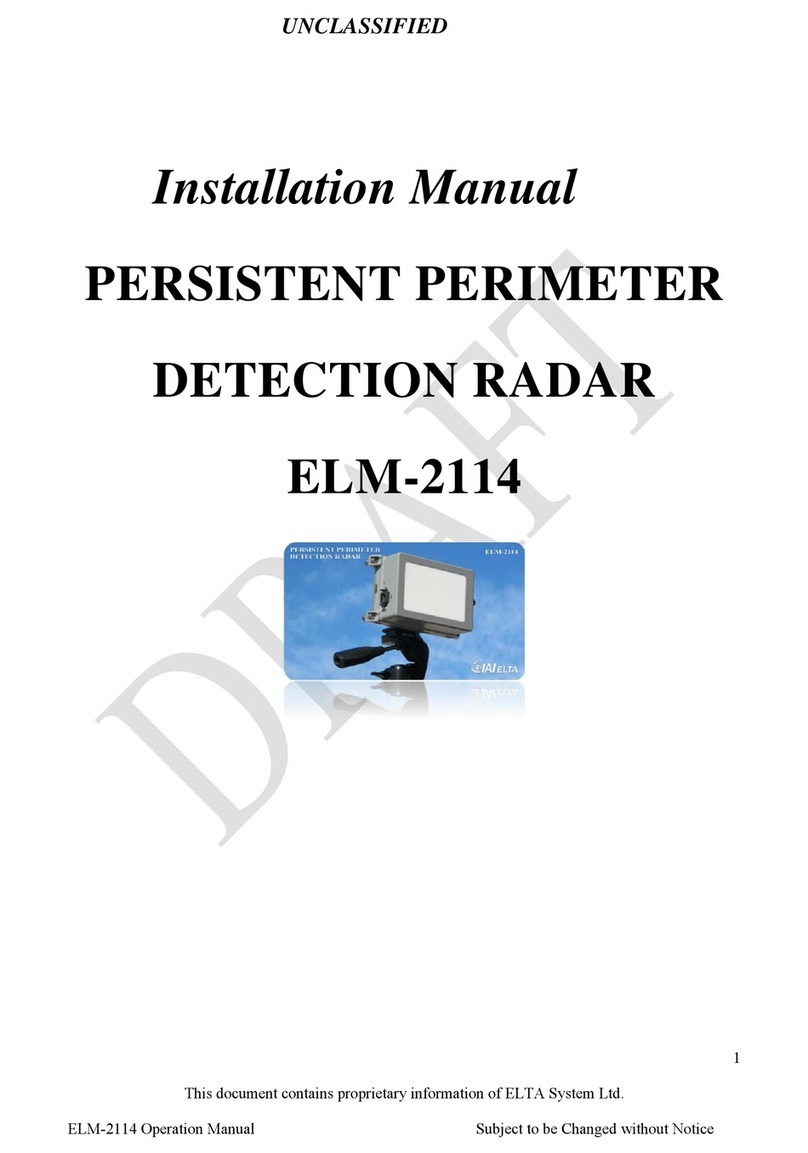
Elta
Elta ELM-2114 installation manual

Furuno
Furuno WR2120 Operator's manual

